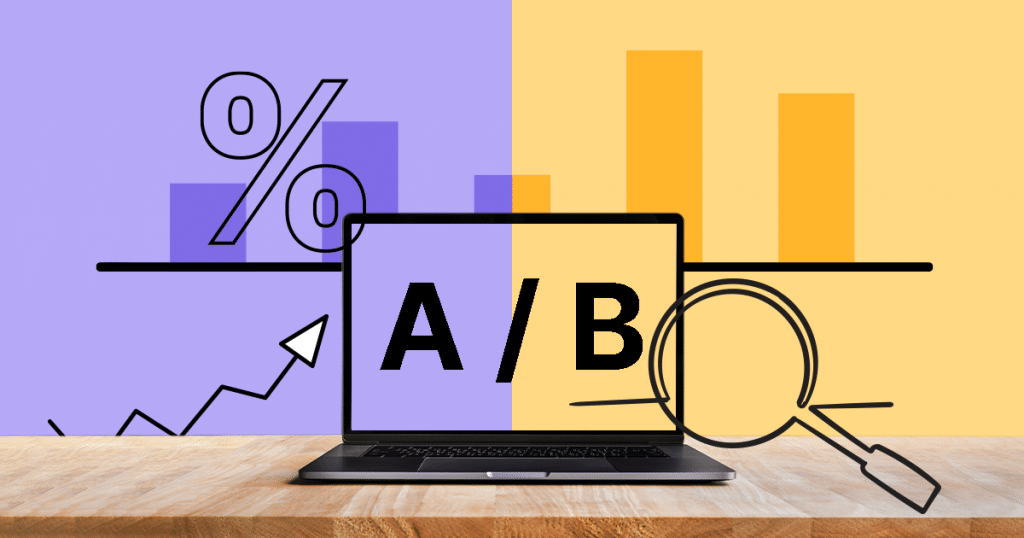Whenever we discuss the benefits of Digital Marketing, we constantly reiterate that your strategy’s approach is particularly crucial to achieving genuine results.
Conducting marketing initiatives on Internet platforms requires technical knowledge and versatility to analyze and optimize the performance of several different advertising campaigns simultaneously.
Therefore, you must closely monitor the performance of your strategy. Based on metrics such as the engagement rate, it is feasible to improve the customer experience constantly. Few tools are as fundamental in this process as A/B tests.
By A/B testing your pages and contents, you will be able to identify the best ways to communicate with your audience. Want to know more about it? In this text, you will learn:
- What is A/B testing?
- How can A/B testing benefit your strategy?
- How to use A/B tests in your strategy?
Keep on reading!
Download this post by entering your email below
What is A/B testing?
A/B testing, also known as split testing, is the method used to compare two variables of a marketing strategy in order to identify which performs best. You can apply it to the content of a blog production, for instance.
Imagine that you are deciding over which type of visual resource to insert in your blog posts. Is it better to use an image to illustrate the content, or would a video generate more engagement?
By running an A/B test between two blog posts, one with images and the other with a video, you can quickly gain a sense of audience preference.
Shortly, we’ll detail how this process takes place. For now, it’s more important to establish that while bearing similarities, A/B testing is distinct from multivariate testing.
Both are techniques used to compare performance, but A/B testing allows the comparison of only one variable at a time.
To understand better, let’s return to the example of blog posts. If aside from visual content, you want to test the different calls-to-action, you will need to run two different tests. This way, you will have adequate time to run both tests and thereby ensure more accurate results.
Once equipped with these data results, you can make data-driven decisions instead of resorting to mere intuition.
As a consequence, your brand will provide an increasingly satisfying experience for the customer, as well as enjoy various benefits.
We will talk more about those next!
How can A/B testing benefit your strategy?
Once a system is completely data-based, an A/B testing analysis offers nearly everything to generate more efficient data-based decisions. But what are the real benefits that these decisions create exactly? Well, it depends directly on your strategy goals and the particularities of your company.
However, it’s possible to mention some advantages which invariably come with any A/B testing strategy.
To start with, testing allows you to gain more behavioral knowledge about your audience, a fundamental tool for companies in any industry.
Little by little, this knowledge can allow you to customize the customer experience and, by applying this knowledge to the constant customization of customer experience, you will generate increasingly loyal customers.
Moreover, retaining customers and establishing long-term relationships are not the only advantages. In fact, A/B tests are essential for growing the lead generation itself.
Based on data analysis, you can identify, for example, factors that allow you to optimize your conversion rate. To do so, you just need to know what type of variable you should be testing.
If your strategy focuses on landing pages to generate opportunities, it’s certainly a good idea to perform tests to ensure the efficiency of the page’s contents.
In this context, you could create different landing page versions and test different variables, remembering to respect the limit to two at a time.
So, if you want to decide between two form types, simply look at the results and see which version presents the best outcomes.
If well-executed, this process results in an even higher Digital Marketing ROI, since it will be possible to convert a greater percentage of your website visitors.
The A/B testing can also be used to solve problems found in your performance reports. If you notice, for example, that your bounce rate is too high, you will probably want to take immediate action. However, the solution is not always so simple.
If you have already tested the speed and responsiveness of your pages, the problem should reside in its content.
Remember that the bounce rate calculates the percentage of visitors who leave the website without taking any action. The reasons can be several, from the page’s design to the font you use in your texts.
Whenever you encounter a problem like this, you can run A/B tests until you discover which elements generate the most satisfactory results.
Yes, this may be a difficult process, but one that brings limitless benefits to your business.
How to use A/B tests in your strategy?
Now that you know more about the advantages of A/B testing let’s turn our attention to its implementation.
After all, like any analytical method, results only appear if you know how to find them.
So, the first question you should ask yourself is: what do I want to test?
Throughout the text, we have stressed the importance of testing only one variable at a time. However tempted we may feel about testing several elements at once, this will negatively affect the reliability of the results.
The good news is that you can choose from an infinite number of elements to test.
Just on a landing page alone, for example, you can try the following elements:
- titles;
- headlines;
- CTAs;
- images;
- organization of elements;
- URL;
- fields of a form;
- design.
Once you have defined which element to test, you need to ensure that your company can do suck a task. This starts with data collection.
It’s important to work with reliable data sources that bring relevant information to help you achieve your goals. To do this, you can use analytical tools such as Google Analytics.
A very interesting way to increase data generation is by producing interactive content.
As it requires the user to take action, this type of content, in addition to increasing engagement, generates valuable insights into visitors’ behavior on a web page.
Based on the areas of content that received the most clicks, for example, you can set certain audience preferences. The more you know about the customer’s behavior, the less preoccupied you will be over questions concerning which types of elements you should use.
However, let’s get back to A/B testing. If you have the necessary access to data and have chosen your goal, it’s time to create your hypothesis.
If your objective is to increase the rate of email openings, you need to develop a hypothesis that can be tested. For example: the use of emojis will generate an increase in the opening rate.
In this case, to test if the hypothesis is true, you must create two versions of email, one with emojis and one without them. They should be distributed to different segments of subscribers, and their results should be properly recorded.
This way, you can identify the one which generates the best feedback.
How to run your tests?
Although it is possible to run your tests manually, such process can take a lot more time and work.
Therefore, the ideal solution is to find marketing automation tools that offer A/B testing as a resource. The most qualified email marketing platforms, for example, already do this.
Ion Interactive, a platform for creating interactive content, offers fast A/B testing as an advantage to its users.
In the video below, you can see how the software makes it easier to create A/B tests of different types.
Facebook Ads Manager, responsible for managing social networking campaigns, also allows you to create A/B tests before placing your ads.
So, to run your A/B tests, look for the tool that best fits your goals, making sure it can accurately test your hypothesis.
In the end, you need to know how to evaluate the results. The software used for running the tests will present a report showing the discrepancies between the two versions.
All you have to do is correlate the results with your strategy goals.
A/B testing is a technique that has enormous potential to optimize your conversion rate. You can apply it to different scenarios, but remember always to use reliable data. Every detail of your content can make a difference in its performance.
A/B testing is one of the many marketing terms you need to learn to extend your knowledge in the field.
We know that it’s challenging to memorize them all. That’s why we created this post listing 18 Digital Marketing terms that every marketer needs to know. Check it out!







